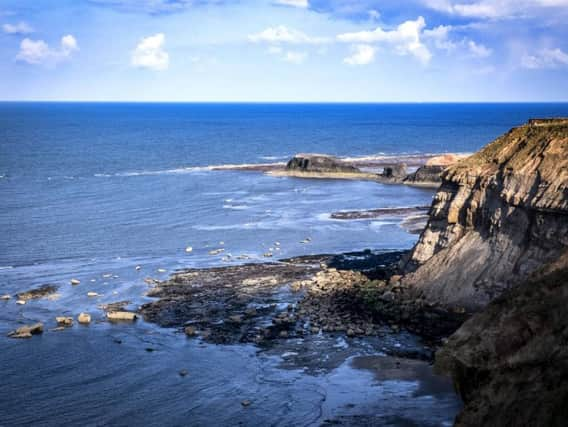The shipwrecks you can still see along the Yorkshire coast


It's thought that since commercial seafaring began in around 1500, an average of two vessels each week have run aground off Bridlington, Scarborough and Whitby - although the number has dwindled to almost none in recent decades since maritime technology improved.
In 1869, a particularly bad year, there were over 800 wrecks along a 100-mile stretch from Spurn Point to the Tees.
Advertisement
Hide AdAdvertisement
Hide AdAmerican warship which sank in 1779 discovered off Yorkshire coastAround 50,000 wrecks lie somewhere off the Yorkshire coast, many attributed to lax 19th-century shipping regulations. Coal barges sailing from the Tyne were often overloaded and in a state of poor repair, and were often swamped and sunk. Strong currents, treacherous rocks and violent storms put paid to thousands of merchant and fishing boats.
The invention of lighthouses and the formation of organised lifeboat crews reduced the death toll, but before modern navigation aids were available, ships struggled to avoid rocks and reefs, relying on charts and their captains' knowledge.
Here are some of the wrecks that can still be seen on the Yorkshire coastline:-
SS Rosa
This steam-powered Royal Navy fuel barge went down in 1930 and her boiler can be seen at West Scar, North Landing near Flamborough. The crew of 16 were rescued by the Flamborough lifeboat.
Advertisement
Hide AdAdvertisement
Hide AdThe Italian cargo ship was wrecked in 1923 after running aground at the base of Bempton Cliffs, near the RSPB sanctuary, in thick fog. The boilers and propellers can still be seen. She had been sailing from Newcastle to Venice carrying 5,000 tonnes of coal, and had struggled to stay on a safe course. The crew were rescued.
Sarb-J
A more recent casualty, the fishing trawler beached near Robin Hood's Bay in 1994 after its propeller became tangled in rope. The crew were airlifted off. The remains of the boat are still visible beneath the cliff.
Admiral von Tromp
The wreck of the Scarborough-based Tromp on Saltwick Bay is a true maritime mystery. She sank in 1976, but nobody knows why. She had been heading for the Barnacle Bank fishing grounds, and all seemed normal among the crew when she left port. The captain set the course before retiring and leaving John Addison at the wheel. He awoke to find that the vessel had foundered on the notorious Black Nab rocks, the worst reef on the coast. Addison appeared stunned, and the weather was fine. Experts later said it could not have changed course so drastically without human intervention.
Advertisement
Hide AdAdvertisement
Hide AdThe fascinating graveyard of World War One military craft that lie off the Yorkshire coastThe rescue was difficult, as heavy swell prevented the men from hanging onto the side of the boat, and they retreated to the wheelhouse to await assistance. After an hour, their heads reached the ceiling, and they had to swim through a window to escape the rising water. Addison had drowned already, and crewman George Eves died when he was swept off the roof by a large wave.
The Whitby lifeboat attended the scene, but struggled to get close enough to safely reach the remaining crew. The vessels were even touching at one point, but rocket lines thrown to the men failed as they were still inside the wheelhouse. They were eventually rescued.
Creteblock
Perhaps the most pathetic casualty of the coast, the Creteblock sank when it was being towed on its way to be scrapped in 1947.
The former coal barge and harbour tug had lain derelict in Whitby since 1934, and it was decided to deliberately scuttle it out to sea. However, it hit shallow water at Whitby Scar, and ran aground at Saltwick Nab. As a hazard to other shipping, the wreckage was blown up, but some large pieces of concrete debris can still be spotted.
SS Rohilla
Advertisement
Hide AdAdvertisement
Hide AdAlthough no visible wreckage survives above the surface, this 1914 grounding was one of the worst losses of life on the Whitby stretch of coast. The Rohilla was a requisitioned hospital ship on its way to evacuate wounded soldiers from France when it came to grief in a gale. The shore lighthouses were unlit during the war to deter enemy activity, and the captain believed they had hit a mine, although this was never confirmed. The death toll was 84, but all of the nurses and a Titanic survivor were rescued by RNLI lifeboats over a 50-hour period.
This lost naval wreck was the most mythical on the coast until it was sensationally discovered last year. The resting site of the Bonhomme Richard had puzzled wreck-hunters for decades as they searched the waters near Filey. Everyone knew it was there - but nobody knew exactly where.
The vessel was a US Navy warship that was the first to defeat the Royal Navy in British waters during a pitched sea battle that astonished those who witnessed it.
Advertisement
Hide AdAdvertisement
Hide AdIn November 2018 it was announced that wood from the ship had been found, and that a wreck off Flamborough Head had been wrongly identified and was in fact the Bonhomme Richard. The ship, captained by the US Navy's 'founding father', John Paul Jones, foundered after a battle with British ship Serapis in 1779, during the American War of Independence.
When its captain Richard Pearson asked if Jones had surrendered, Jones famously replied, "Surrender? I have not yet begun to fight!" Although Jones won the battle and captured the Serapis, the Bonhomme Richard was badly damaged in the three-and-a-half-hour engagement and sank about 36 hours later during a storm.
The site is expected to be of huge interest to American tourists.
It had been confused with the remains of another wooden warship, HMS Nautilus, which lies nearby, but the wood recovered show signs of fire damage consistent with Bonhomme's sinking.